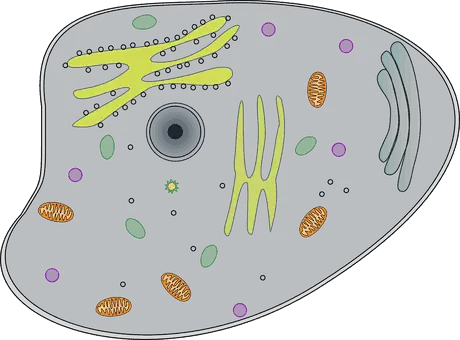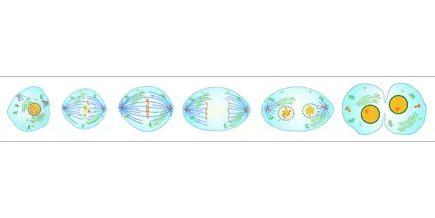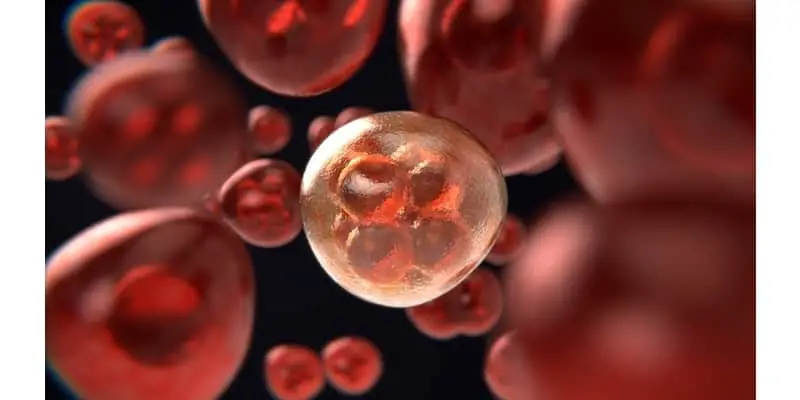Eukaryotes are organisms made up of one or many cells which have a clearly delineated nucleus bound by a nuclear membrane. In fact the name “Eukaryota” is greek and loosely means well formed nut or kernel referring to the clearly defined nucleus at the center of the cell. Eukaryotic cells are also defined by the compartmentalization of the cell into distinct structures called organelles.
Organelles act, as their name implies, as “organs”, for the cell. Organelles all have distinct functions to aid the cell in interaction with the environment, and potentially to work with neighboring cells to build large colonies and organisms such as plants and animals. Eukaryotic cells are found in many different types of organisms we can see with the naked eye like plants, animals, and fungus. There are also eukaryotic cells that belong to tiny unicellular organisms that require a microscope to see.
There is also another classification of cell that is the opposite of a eukaryotic cell in terms of classification, and that is called a prokaryotic cell. These cells as you would expect do not have cell membrane enclosed organelles. For more on prokaryotes see this post.
In this article we will explore more about characteristics and attributes of eukaryotic cells and understand some of the associated biological processes that these cells undergo.

History
The distinction between eukaryotic and prokaryotic cells is credited to Edouard Chatton in 1937 when he observed and outlined that there was a clear difference in the cell structure of bacteria and blue-green algae compared to other organisms. Chatton called this distinction the “Eukaryotic type” and “Prokaryotic type”.
Following Chatton, Roger Stanier and C.B van Niel popularized the distinction in 1961 and this has been the prevailing distinction between domains of cells until recently. In the 1970’s professor Carl Woese discovered a group of bacteria that might not fall into either the prokaryotic or the eukaryotic domain. These bacteria are were named archaebacteria because they were a group of ancient bacteria that were thought to be among the first on the planet. For more on archaebacteria see this post.
Similarities Among Organelles in Eukaryotes
The key difference between eukaryotes and prokaryotes are membrane-bound organelles. There are differences between Plant, Animal, Fungi, and Protista eukaryotes, but there are some major similarities between them.
Internal Membrane
All Eukaryotes have an endomembrane system. These compartments are called vesicles and vacuoles. These allow for ingestion of food and construction of other organelles. Generally, the nucleus is encapsulated in a nuclear membrane, which is semi-permeable to certain materials. From the nuclear membrane, there is the endoplasmic reticulum, which helps transport proteins. This includes ribosomes where proteins are created.
Mitochondria and Plastids
All eukaryotes have mitochondria, the “powerhouse of the cell”. Here, sugars are converted into ATP (adenosine triphosphate) which provides energy to other organelles.
Mitochondria have two membranes, one which allows most molecules in and out and a more selective inner membrane which selects the chemicals needed for energy conversion. Mitochondria also have their own DNA, as they developed from prokaryotes and share mitochondria with prokaryotes.
Although eukaryotic mitochondria function differently in terms of converting molecules into useable energy, plants and certain algae have plastids – another type of “energy-factory” for cells.
These plastids are what is responsible for photosynthesis in plants, which take chlorophyll and produce sugars for energy. Other types of plastids are responsible for storing food for the plant for later use.
Cytoskeletal Structures
Eukaryotes can have flagella that are responsible for movement, feeding, and sensing of their environment. While similar in some ways to the prokaryote’s flagella, they are very different.
They consist of different chemicals, which may contain cellular “hair”, and are actually connected to the interior cytoplasm of the cell. These structures are critical in determining the shape of the cells, as well as their chemical responses to their environments.
Eukaryote Classification
Eukaryotes are classified into four types:
- Animals
- Plants
- Fungi
- Protists
Animal Cell
With the above common traits, there are certain traits that differentiate animal, plant, and fungal eukaryotic cells. The simplest is the animal cell. They do not contain a cell wall, and so they are much more variable in structure and function. They do not have any chloroplasts for photosynthesis.
Plant Cell
Plant cells differ from animal cells by a lot. The first difference is the presence of a cell wall encapsulating the entire cell. This is what causes plants to look so much more rigid and structured under a microscope.
Because of the rigid cell wall, plant cells do not have flagella which let them move about. Instead, there are plasmodesmata which allow for communication to neighboring plant cells. Other major differences are plastids such as chloroplasts. This is what gives the cell chlorophyll, and that signature green color. Without chlorophyll, photosynthesis could not take place.
Fungal Cell
Fungal cells are similar to animal cells but remain in their own category. Fungi cells have a cell wall, but it is a completely different chemistry than plant cell walls. Fungal cells are less organized than animal or plant cells, as their organelles often overlap with on another. This gives off an appearance of a “super cell”.
Protist Cell
Protist cells have all the typical components of a eukaryotic cell in that they contain a clearly defined and bound nucleus and organelles, however there are some structures that protists have that other eukaryotic cells do not.
For example some protists have flagella which are whip like antennae structures that can aid in movement of the protist or help with capturing food. Paramecium have vacuoles help regulate the amount of water and pressure inside the cell. Euglena have a red eyespot that aids in helping the euglena find sunlight which the chloroplasts in the euglena turn into energy.
Reproduction and Lifetime
Eukaryotic cells do no reproduce by binary fission like prokaryotes. But they reproduce asexually by a process called mitosis. In this process, chromosomes are copied, and then daughter nuclei are created which eventually reproduce an identical cell to the parent with all needed organelles.
Generally, these cycles vary considerably for animals, plants, and fungi. But in summary, this reproduction is much more involved than prokaryote duplication. Eukaryotes are evolved to have a lower metabolic rate which leads to longer generation times.

Origins
The origin of eukaryotes are a little harder to discern than prokaryotes. Because Eukaryotes are vastly more complicated than prokaryotes, their evolutions is generally harder to trace. At what point does an evolving organism constitute as a eukaryote? What if they lack some features that a normal eukaryotic cell should have? What if they still have some of their primordial features? This is an active area of research.
Some researchers suggest formation of eukaryotes happened around 1.8 billion years ago, while other algae are found 2.1 billion years ago. Regardless of actual date of origin, eukaryotes were very simple until only 800 million years ago, where their population and complexity sharply rose.
Takeaways
Eukaryotes are responsible for most of the visible and large-scale, complex life we see today. Although they make up small percentage of living things, they make up nearly half the biomass because of their size. This is a testament to how complex life can be.
Nearly half of life is tiny bacteria and prokaryotes and the other half are trillions of eukaryotic cells that make up plants, animals, and fungi that we can see with the naked eye! Eukaryotes are divided into four categories: the well known Plantae, Animalia, and Fungal, but also the Protista.
All are very complicated and unique and compose the wonderful diversity of life we can experience today, including ourselves as humans!
References
- Whitman WB, Coleman DC, Wiebe WJ (June 1998). “Prokaryotes: the unseen majority” (PDF). Proceedings of the National Academy of Sciences of the United States of America. 95(12): 6578–6583. Bibcode:1998PNAS…95.6578W. doi:10.1073/pnas.95.12.6578. PMC 33863. PMID 9618454.
- Sapp J (June 2005). “The prokaryote-eukaryote dichotomy: meanings and mythology”. Microbiology and Molecular Biology Reviews. 69 (2): 292–305. doi:10.1128/MMBR.69.2.292-305.2005. PMC 1197417. PMID 15944457.
- Knoll AH, Javaux EJ, Hewitt D, Cohen P (June 2006). “Eukaryotic organisms in Proterozoic oceans”. Philosophical Transactions of the Royal Society of London. Series B, Biological Sciences. 361(1470): 1023–1038. doi:10.1098/rstb.2006.1843. PMC 1578724. PMID 16754612.
- Retallack GJ, Krull ES, Thackray GD, Parkinson DH (2013). “Problematic urn-shaped fossils from a Paleoproterozoic (2.2 Ga) paleosol in South Africa”. Precambrian Research. 235: 71–87. Bibcode:2013PreR..235…71R. doi:10.1016/j.precamres.2013.05.015.
- Isson TT, Love GD, Dupont CL, Reinhard CT, Zumberge AJ, Asael D, et al. (June 2018). “Tracking the rise of eukaryotes to ecological dominance with zinc isotopes”. Geobiology. 16 (4): 341–352. doi:10.1111/gbi.12289. PMID29869832.

